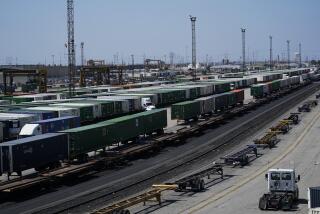SANDAG Traffic-Control Plan Assailed
- Share via
The county’s top pollution-control official Tuesday sharply criticized a countywide program to ease traffic congestion, saying it falls far short of meeting state air standards and fails to follow the basic requirements laid out for it.
The plan drafted by the San Diego Assn. of Governments “was biased against transit expansion, a key transportation control measure,” said Richard Sommerville, executive director of the Air Pollution Control District. “The infrastructure and other measures to provide alternative modes (of transportation) were not included. Finally, only commute travel was addressed, which comprises a fraction of the total travel.”
Sommerville made his comments Tuesday to the county Board of Supervisors, sitting as the air board, which in turn asked him to report back Jan. 8 with specifics about the failures of the Sandag plan. Sandag officials did not attend the meeting and could not be reached for comment afterwards.
Earlier this year, Sandag and the air board had tussled over who would get to draw up the traffic-management plan, designed to reduce traffic and pollution by getting people out of their cars and also by affecting land-use decisions. Under an agreement still being formalized, the two agencies eventually decided that Sandag could go ahead and draw up the plan but, in doing so, had to follow criteria set up by the air board.
Instead, the Sandag board adopted its plan on the same day it received the criteria, Nov. 16, without taking them into consideration.
“I think their actions were very precipitous,” Sommerville said at the time.
The Sandag program calls upon employers to use both incentives and penalties to urge their workers out of commuting to their jobs alone. Car pools, preferred parking, bus pass subsidies, staggered working hours and other proposed methods of cutting down on rush-hour traffic and discouraging solo commuters were proposed.
But Sommerville criticized the Sandag plan as inadequate to address the county’s air pollution problems and recommended to supervisors that they send notice to Sandag and city officials “informing them that the APCD board does not approve of the Sandag program and advising them that adoption of the Sandag model may be premature.”
Relieving traffic congestion during rush hours is only one factor in the state program to improve air quality by cutting down on vehicle emissions, Sommerville said. Even if all the traffic control measures proposed by Sandag were undertaken, he said, the county would fail to meet the state mandate to reduce air pollution by 5% a year.
The air board on Tuesday publicly released the criteria that Sommerville said Sandag was supposed to follow. Among them:
* Reduction of vehicle trips and trip lengths so that the rate of increase of vehicle use would be at or below population growth. Vehicle use now is increasing at almost twice the rate of population growth.
* An average of 1.5 riders per vehicle during weekday commuting hours.
* Special measures to alleviate carbon monoxide “hot spots” in downtown San Diego and Escondido, including conversion of especially congested streets into pedestrian malls, conversion to one-way streets and other restrictions on traffic.
* Crackdowns on solo motorists, including increased parking fees and limiting the number of parking spaces. Car-poolers would be rewarded with preferential parking and free parking or reduced parking fees.
* Prohibition on trucks idling for more than 5 minutes, except when necessary. Providing freight consolidation centers to ensure that all trucks travel fully loaded for maximum efficiency.
More to Read
Sign up for Essential California
The most important California stories and recommendations in your inbox every morning.
You may occasionally receive promotional content from the Los Angeles Times.










